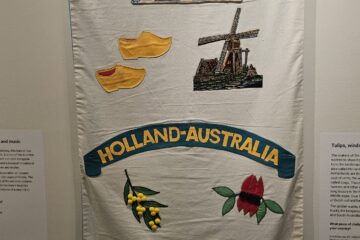Obviously the Big Australian Gold Rush that started in the 1850s and 1860s had also reached the news in the Netherlands. It looks like that several potential prospectors signed on as sailor on the many merchants ship with the aim to jump ship in Australia and try their luck on the gold fields, Other sailors were perhaps told about the gold during such a boat trip and followed the same example and jumped ship. They then often made their way to the goldfields on foot.
One of the most famous Dutch jumpers was a man named Johan Carl Zwartz. He arrived in Australia in 1853 aboard the ship “Bussorah Merchant.” However, he soon became disillusioned with the poor living conditions and low wages offered to him by his employer. In 1854, he jumped ship in Melbourne and made his way to the goldfields in Ballarat, where he worked as a miner.
Zwartz’s story is not unique. Many Dutch migrants made the decision to jump ship and join the Gold Rush, despite the risks involved. In some cases, they were successful and made a fortune, but in others, they found little gold and struggled to make ends meet.
It’s worth noting that jumping ship was a risky and often illegal act. Those caught jumping ship could face imprisonment or deportation. However, for some migrants, the potential rewards of participating in the Gold Rush were worth the risk.
Other Dutch gold diggers include:
Pieter Dogger was a Dutchman who arrived in Victoria in the early 1850s and worked as a miner in the Ballarat region during the Victorian Gold Rush. He later became a successful businessman and landowner in the area, and was known for his involvement in local politics and community affairs.
In addition to his business and landowning activities, Dogger was also active in local government. He served as a member of the Ballarat Municipal Council in the 1860s, and was elected mayor of the city in 1873-74. During his tenure as mayor, Dogger focused on improving the city’s infrastructure, including the construction of new roads and bridges. He was also involved in the establishment of several educational institutions in the area, including the Ballarat School of Mines.
Dogger was a prominent member of the local Presbyterian Church and was involved in several charitable organizations in the area. He was also known for his support of the temperance movement, which sought to promote abstinence from alcohol.
Herman C. Verstegen was a Dutchman who arrived in Victoria in 1853 and began mining for gold near the town of Beechworth. He later became a prominent businessman and landowner in the region.
Johan August Van Haandel was another Dutchman who arrived in Victoria in the early 1850s and became involved in the gold rush. He later went on to establish a successful brewery in the town of Mildura.
Jan Van Grootel was a Dutchman who arrived in Victoria in the early 1850s and worked as a miner in the Ballarat region. He later became a successful businessman and landowner in the area.
Peter Brouwer was a Dutchman who arrived in Victoria in the mid-1850s and worked as a miner in the Ballarat region. He later went on to become a successful farmer and landowner in the area.
Johannes Klinkhamer arrived in Victoria in 1852 and became a successful miner in the Ballarat region. He later became a hotelier and owned several hotels in the area.
Willem Rees arrived in Victoria in 1853 and worked as a miner in the Ballarat region. He later became a successful businessman and landowner in the area.
Gerrit Bult came to Victoria in 1853 and worked as a miner in the Bendigo region. He later became a farmer and landowner in the area.
Hendrik Hiddingh arrived in Victoria in 1852 and worked as a miner in the Ballarat region. He later became a successful businessman and landowner in the area.
Klaas de Korte came to Victoria in 1853 and worked as a miner in the Ballarat region. He later became a farmer and landowner in the area.

Overall, Dutch migrants were just one group of many who came to Australia during the Gold Rush in search of fortune and a better life. Their stories provide a glimpse into the challenges and opportunities that faced those who participated in one of the most significant events in Australian history.
Edward Duyker in his book: The Dutch In Australia, found that of the 165 Dutch individual who arrived in Australia between 1845 and 1905 half of them arrived during the gold rush period. All but one were men and their average age weas 25 years , they waited 20 years to be naturalised.
Jumping ship seems to have been a serious issue. The origin of the Dutch Queen Wilhelmina Benevolent Trust Fund dates back to 1903 when it was setup to support Dutch sailors who jumped ship and became in need of support to survive.
See also:
Jan Vennik – and other Dutchmen at the Eureka Stockade (1854)
Dutch immigration to Australia, history, stats and other resources


